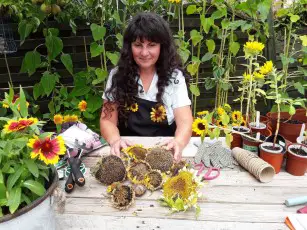One of my favorite times of year is harvesting sunflower seeds, my first favorite being when they’re fully in bloom.
But it’s now that time of year that I can show you when and how to harvest your seeds. there are a few ways to store them to replant, and different ways to feed wildlife when their winter cupboards are empty.
Like most people I really love sunflower seeds, they’re delicious raw, cooked or roasted and are good for you, more on that later. But first, once you’ve gone past the sunflower blooming stage, I’d like to take you through the process of harvesting sunflower seeds.
Here’s a quick take away of the process so you can get started or you just need a refresher on what to do. Otherwise, read further for my best tips and tricks for harvesting your sunflower seeds.
Table of Contents
How to Harvest Sunflower Seeds
- You’ll need some garden shears, a wide bucket or lid, and garden gloves
- Ensure the flower head is drooping – almost directly downward
- The back of the sunflower head should show signs of drying, yellow with brown patches
- Petals should be shriveled and dried
- Cut the head off the stem at around 4 – 6 inches from the rear of the bloom
- Wearing the gloves, scrape away and discard the disc florets
- Then with gloves still on, scrape the sunflower seeds into your bucket or bowl
- Sift through to remove unwanted sunflower plant matter and dust
- Wash and season the seeds before use
- Dry out the seeds and they’re ready to use
- Use for wildlife seeds, for roasting or preserving for replanting.
Ok, that’s the quick reference, now let me take you through the full process step by step … along with some hidden tips and tricks that you may not know about….that may also be helpful.
When to Harvest Sunflower Seeds
You will only get a short window of opportunity in which to harvest sunflower seeds. Harvest too soon and the seeds won’t be fully ripe. Leave it too long and the critters will get to them and devour all the seeds.
Different varieties of sunflowers come into bloom at different times during the growing season. Dwarf and short varieties can start to bloom at the beginning of summer, whereas taller varieties tend to bloom towards late summer and the beginning of fall.
Although sunflowers can tolerate very hot or being weather or being water logged by rain, this can also affect their growing stages and when they bloom and become ready for harvest.
This may sound a bit ‘hit and miss’ or confusing, so here are all the easy telltale signs that your sunflowers are ready for harvesting, but first…
Let’s start by gathering some tools so you’re fully equipped for the job when your sunflowers are ready to harvest.
1. Equipment Needed
All you need are some gardening or sturdy gloves, secateurs or a sturdy pair of tough cut scissors. A bucket or large bowl, wide enough to catch the sunflower seeds as they fall – but also catch the stray ones that may fly in unwanted directions!
If you’re the safety conscious sort, then you may also want to wear some eye protection in case some fly into your face, or to avoid dust and dirt.
Now let’s look for the signs that your sunflower seeds are ready to be harvested.
2. Drooping Sunflower Head
If the head is drooping almost directly downward, that’s a good sign. At this point, the sunflower has already stopped growing. It will no longer be drawing sap through its stem to feed leaf and stem growth but is putting its energies into maturing its seeds.
It will stay in the ‘head down’ position until all the seeds have matured, dried and then naturally fall to the ground or until it can’t stay upright any longer and collapse, or your local wildlife feast on it – whichever comes first.
TOP TIP: If you notice a few seeds missing from the head this could be a good sign if they’ve fallen out naturally, or maybe critters and birds have started munching on the seeds. This tells us that it’s nearly harvest time…because nature knows 🙂
3. Sunflower Head Drying, Yellow with Brown Patches
Another sign that your sunflowers are ready to harvest is by taking a look at the back of the bloom. If this area has started to turn yellow, and ideally have brown patches too, then it means the sunflower is starting to dry itself out in order to loosen and drop its seeds.
If left to themselves, sunflower seeds would naturally fall out so they can nestle into the ground and lay dormant until it’s time to start growing again, but of course, we’re trying to catch them before they do that, and before the little creatures take them all.
TOP TIP: having said that, I often let some seeds fall to the ground anyway, it seems only right to let nature take her share, she’s been so generous to me, So leaving some for the birds and minibeasts feels fair and right 🙂
4. Petals Shriveling and Drying Out
If your sunflower petals have started to shrivel, dry up and fall out, this could be another sign that your seeds are ready for harvesting. Although this can happen before the seeds are fully mature.
If the surround of your sunflower head is still sappy green, then the seeds may still be in their juvenile stage and not quite fully grown.
The outer shell, or husk, of the sunflower seed, is the first thing to grow. The soft center part of the seed, or kernel, grows later…that’s the part we’ve all been waiting for.
TOP TIP: So, harvesting sunflower heads too soon may result in empty shells. If you’re in doubt pluck a seed, crack the shell and see if it’s got a kernel, otherwise, wait for the signs in 1 and 2
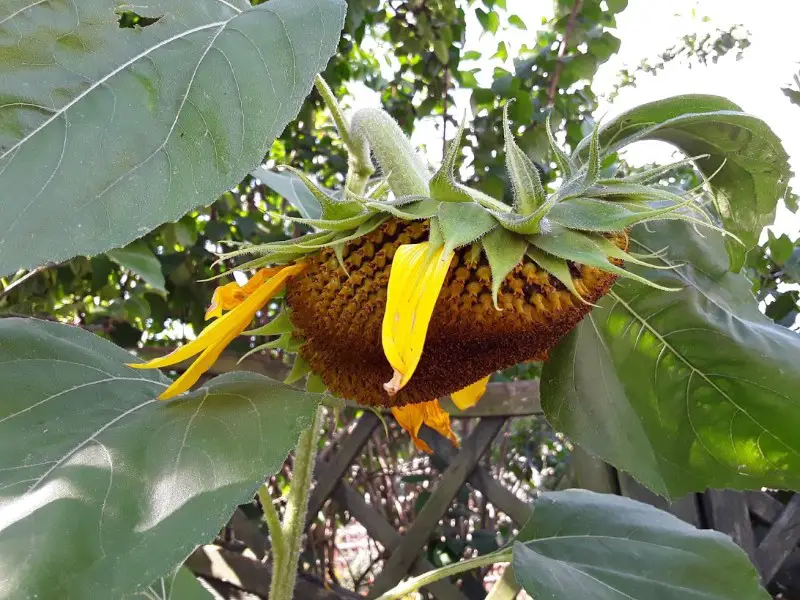
drooping sunflower head, with shriveled petals 
yellowing with brown patches 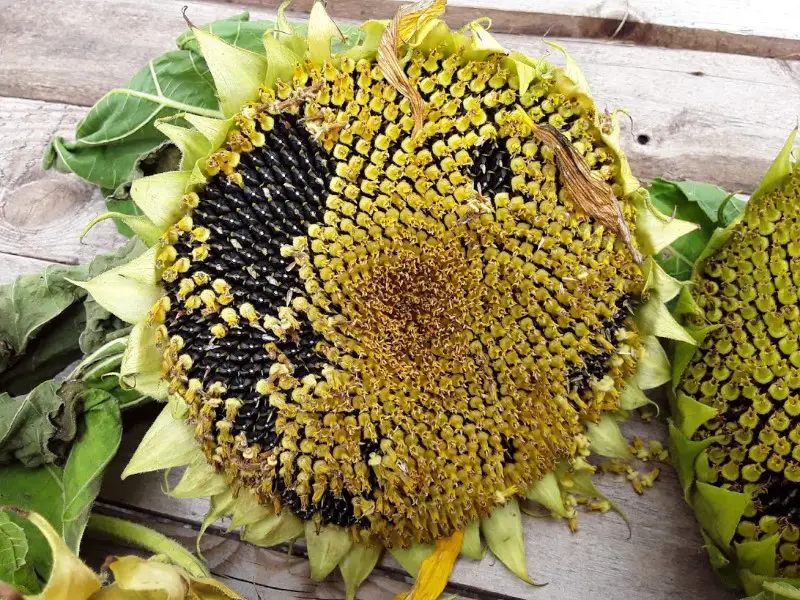
Front of harvested sunflower head 
close up of sunflower seeds ready for harvesting 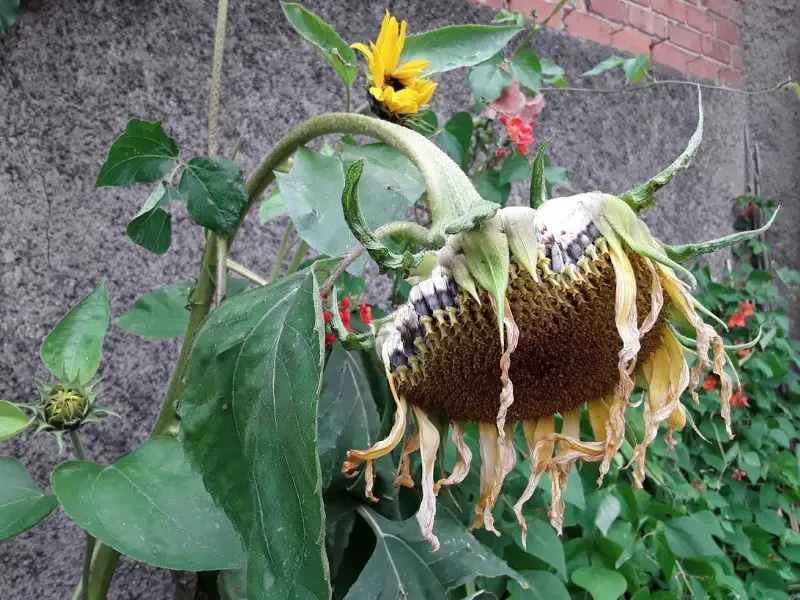
all the signs for harvesting
The signs that sunflowers are nearing the time for harvesting
5. Cutting the Sunflower Bloom
Now you’ve established the sunflower seeds are ripe, get your gloves, cutters, bucket or bowl and let’s get harvesting.
With bowl at the ready, hold on to the stem, or bloom and cut the stem about 4 to 6 inches from the sunflower head.
If your sunflower head hasn’t quite dried out enough, this stem length will give you something to tie it up with and dry out.

cutting the sunflower stem 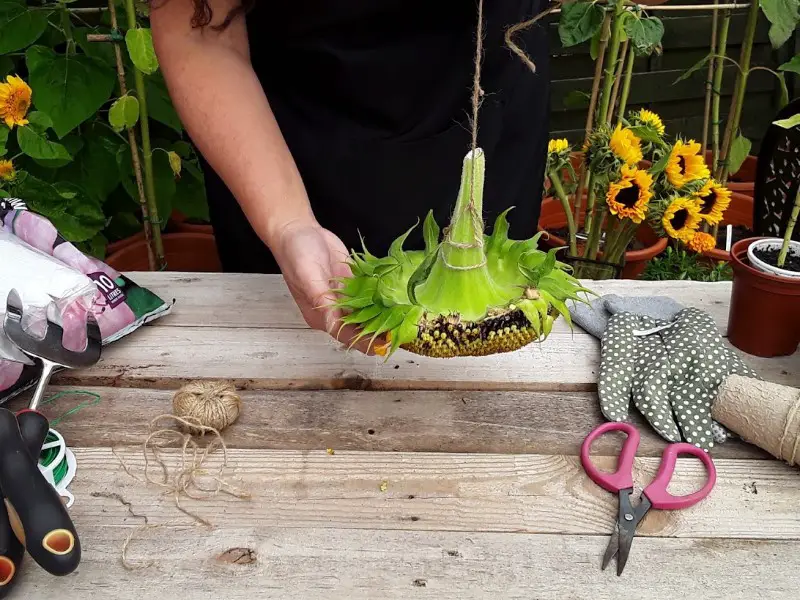
tye the stem to hang for drying 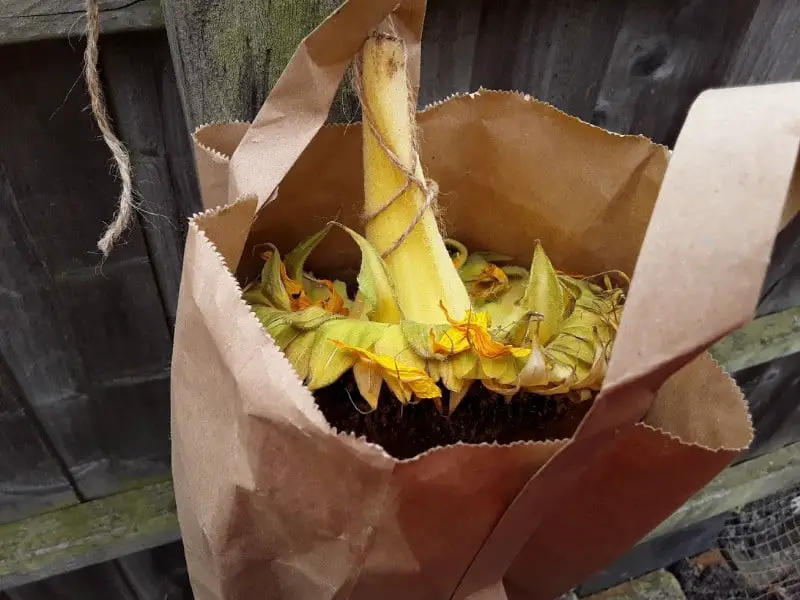
drying sunflower heads in a paper bag 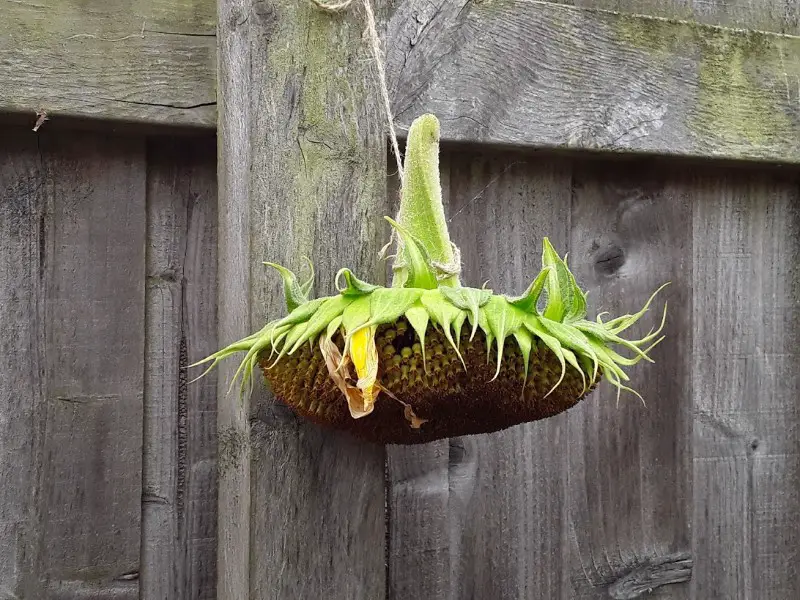
or, hang to dry in a safe dry place
How to cut and hang up sunflowers to dry out the seeds
6. Removing the Plant Matter
Keeping your gloves on start rubbing your fingers over the sunflower florets, pull and peel away the surround of the sunflower head, this part of the plant is called the brack. This will loosen the seeds.
7. Removing the Sunflower Seeds
With your gloves still on, and with more vigor, start rubbing, pulling and plucking at the seeds to remove them from their casings.
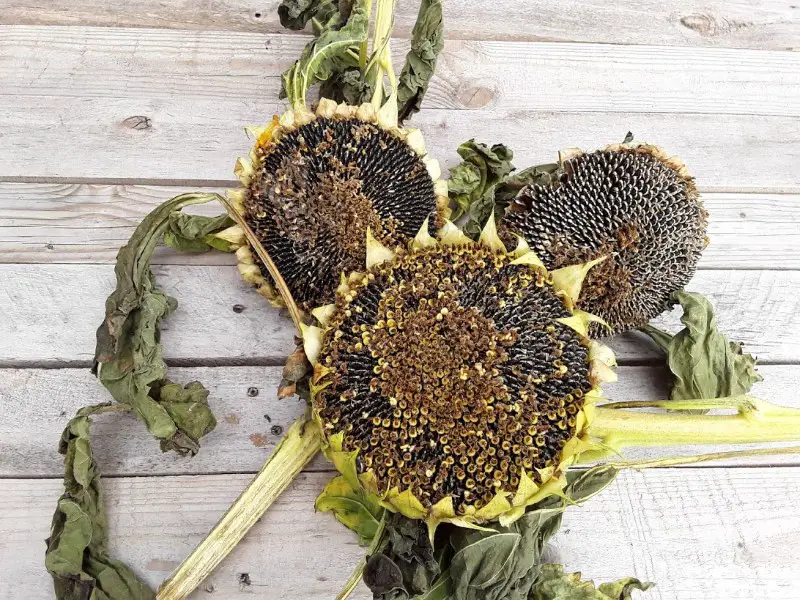
dried sunflower heads 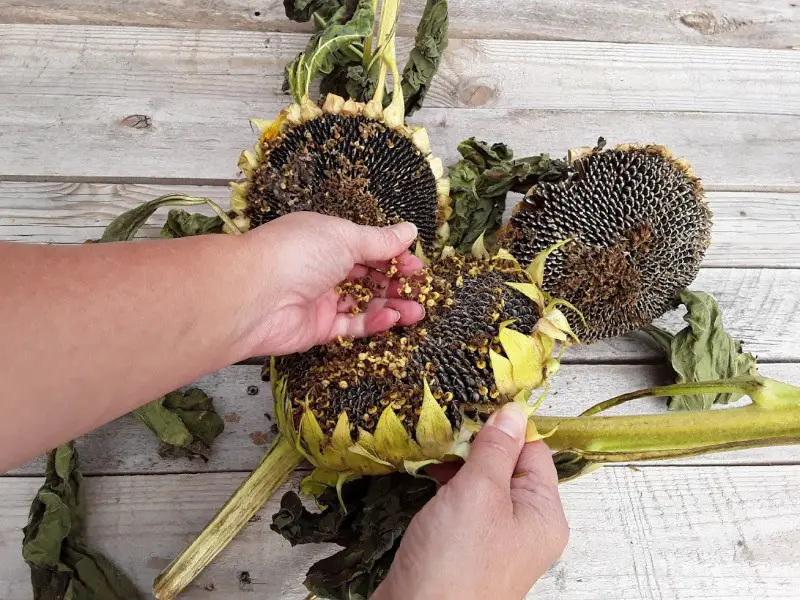
remove plant matter 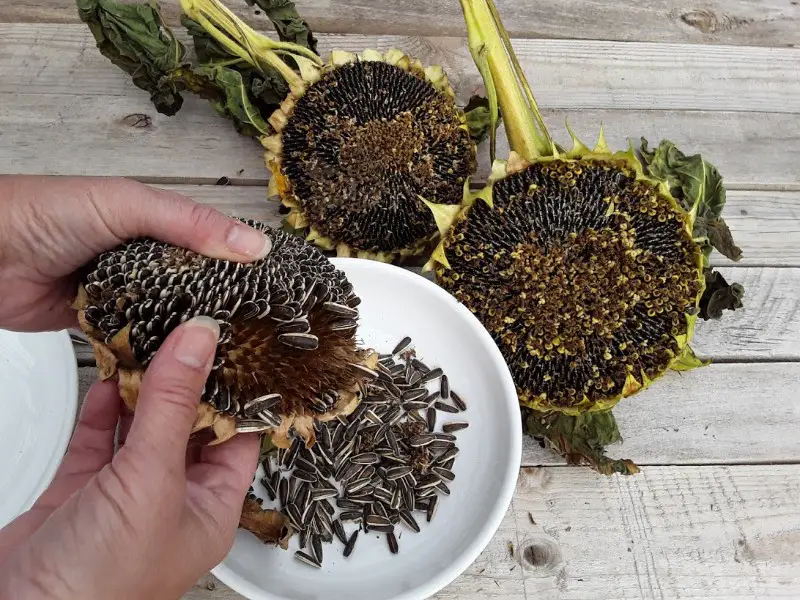
rub and pluck at the seeds 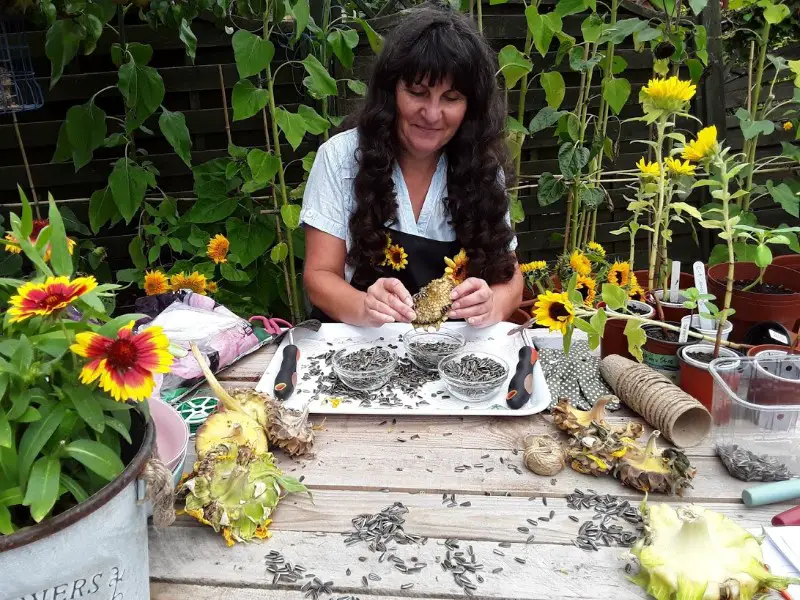
I find harvesting sunflower seeds very satisfying 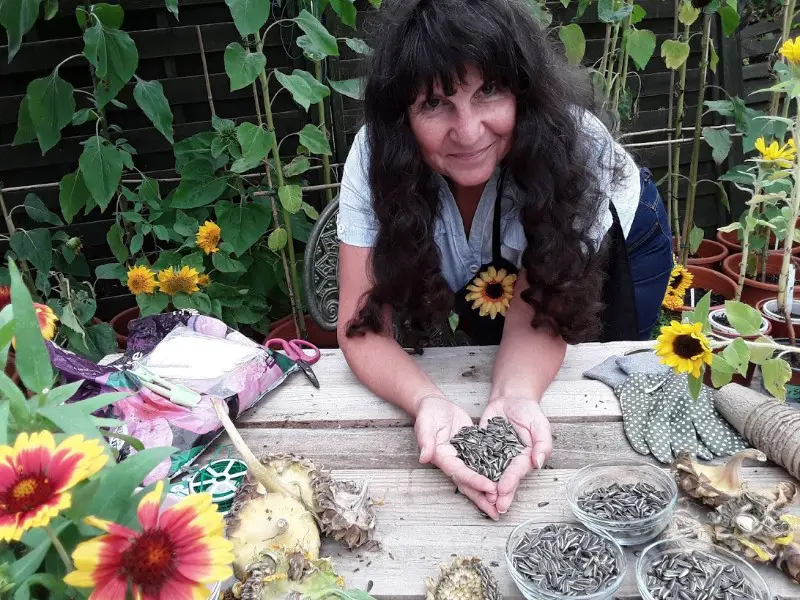
a labor of love
How to remove the unwanted plant matter to harvest the sunflower seeds
8. Remove Unwanted Plant Matter and Dust
This bits easy, and again the kids love helping with this. Once all the seeds are in your vessel, set about picking out most of the larger plant matter. You can add these to your compost heap or dig them back into the soil to mulch down.
Then, if using a flat lid or tray, blow a few times across the seeds – giving them a bit of a shake each time. This will remove lots of dust particles and unwanted matter which will save you picking out later when it’s more difficult when they’re wet from washing the seeds.
9. How to Wash and Season Your Sunflower Seeds
Pour some water into a bucket or bowl and pour the seeds in. This will give them a good wash to remove any stuck on dust particles before processing further.
At this point, you can add some seasoning to the water. Sometimes a few heaped tablespoons of salt into the water and left overnight can really help make the sunflowers more savory. They’ll soak up the water and the savory salt along with it. Leave for a few hours to let them do their thing.
TOP TIP: I add sea salt to this solution, it just gives it that bit more of a sharper, crisp salty taste.
Note: If you plan on using the seeds for wildlife purposes like bird feed, then do not season them. The local beasties like them as nature intended – of course! The same applies if you plan on re-planting any of the seeds for next year’s crop.
10. Drying out Sunflower Seeds
Once washed, empty out the water as much as you can (without losing seeds), rinse again until the water runs clean and then strain your seeds.
layout some clean cloth, tea towels or absorbent kitchen towels, which are perfect for this, spread the sunflower seeds across the towels and with another clean towel pat them dry as much as possible.
If need be, leave them in the sun for an hour or so to let any remaining dampness evaporate.
TOP TIP: Be sure to cover them up if drying them outside. Otherwise, you may just be providing a buffet table to your neighborhood wildlife
11. Ways to Use Your Sunflower Seeds
Your seeds are now ready to use. If you can resist the temptation of tucking in and eating them straight away, or you have too many, then you can…
- Store sunflower seeds for a later date to roast or bake with, and use in other recipes.
- Save them to plant for next year.
- Or use them to feed the birds and wildlife throughout the winter…when their cupboards are bare.
So, here’s how to store them in more detail. And how long you can store them for.
How to Store and Preserve Sunflower Seeds to Eat
Once your seeds are completely dry place them in airtight containers or bags, then store in a consistently cool dark place, a pantry or such like is ideal. You can also store sunflower seeds in the fridge or Freezer.
Label with the date you harvested your sunflower seeds on their containers. Generally, they can be used up to 1 years in the freezer, if they last that long before being eaten. Although, the sooner you use them the fresher they’ll be.
Depending on whether they’re raw, roasted or a recipe ingredient determines their shelf life. Heres a quick take away guide that will help.
How Long Do Sunflower Seeds Last
| Sunflower Seeds. | Stored in a Pantry or Dry Place | Stored in a Fridge/Freezer |
| Raw, with or without shells | 2 to 3 months | Up to 1 year |
| Roasted, Without shells | 3 to 4 months | Up to 1 year |
| Roasted, In shells | 4 to 5 months | Up to 1 year |
| As a Recipe ingredient | Fresh until the quickest expiring ingredient goes bad or off |
Storing Sunflower Seeds for Replanting
After you’ve harvested your sunflower seeds, and gone through the above process of cleaning and drying them, put them in paper envelopes that you’ve written the date and variety on.
Seal the envelopes, put them in airtight containers and store in a dry, cool place until you want to plant them. You can also store them in the fridge or freezer too. Generally, sunflower seeds stay in good health for replanting up to 1 year in dry storage or fridge/freezer.
Replanting Harvested Sunflower Seeds
Harvesting sunflower seeds to sow and grow for next spring is a subject close to my heart and one I want to share with you, in my article How to grow amazing Sunflowers.
How to grow amazing sunflowers guides you to when and how to sow sunflower seeds indoors or outside. How to prepare the ground or pots. And how to plant and care for your sunflowers throughout their growing season.
This guide will help you grow the best sunflowers with fantastic tips and hints for all their growing needs. I also de-bunk lots of mystifying gardening terms.
TOP TIP: if you’re storing any seeds in an outside building, make sure they are protected from your wildlife coming in and munching on them. Place them in dry, tight lidded tins or store in damp free secured cupboards or drawers.
The Best Sunflowers to Grow for Harvesting
The Russian Giant Sunflower and the Titan Sunflower are two of my favorite varieties I grow for eating their seeds. They have giant blooms and have a high yield of big seeds. They’re easy to grow, care for, and the bees and butterflies love them too.
If you can’t find them locally I’ve found them on Amazon for you.
Harvesting Sunflower Seeds for Wildlife
There’s nothing more rewarding for me than seeing my local wildlife feasting on the fruits of my labor, that is, after I’ve taken a few sunflower seeds to eat, preserve, and replant for myself.
So, after you’ve had your share, or are growing sunflowers solely to feed wildlife then you could easily just leave your sunflowers where they are for wildlife to come and get them naturally.
Or if you want to store some to spread out over a period of time to feed them, here are a few ways to do so.
How and When to Provide Sunflower Seeds for Wildlife
When to Provide Sunflower Seeds for Wildlife
There’s a huge variety of wildlife that will thank you for providing them with sunflower seed snacks. They will happily munch on them throughout the year, but there are times that they’ll be even more grateful for a feed.
- All creatures will need a feed during cold winter months when the grounds are frozen and food isn’t growing.
- In springtime. When young birds are being born their parents need to keep up their own strength with all the feeding demands they have on them. Supplying them with sunflower seeds provides a high energy snack that’s easy to find and not far from their nests.
- Newly fledged birds learn from their parents how to feed and where to find food sources. bird feeders are safe havens and sunflower seeds provide a healthy meal for growing baby birds.
- Hedgehogs like sunflower seeds. They’re a high energy food that they can stock up on, during the summer and before hibernation. At dusk, when hedgehogs usually come out, scatter sunflower seeds on the ground. If you have hedgehogs they will find them.
Top Tip: Keep all wildlife feeders clean all year round. This will prevent any mold or nasties affecting your creatures.
Also, if you’re providing a food source for your wildlife be sure to keep your feeding stations topped up.
Birds will use lots of energy finding food, and a feeding station where they can rely on a good meal will be gratefully received. They’ll waste vital energy foraging if their regular food source is gone or empty.
How to Provide and Store Sunflower Seeds for Wildlife
- Go through the harvesting process above, but use only clean, fresh water to wash the seeds, add NOTHING to the water.
- After washing the seeds, make sure they are completely dry. Do not store them if they are damp.
- Place the seeds in airtight containers, tins or sealed bags. And label with the date of harvesting.
- Store in a damp free, dry place.
- Storing in smaller separate containers will ration the seeds out to use over a period of time. Leaving the rest to stay fresher.
- Fill your feeding stations regularly and enjoy the show.
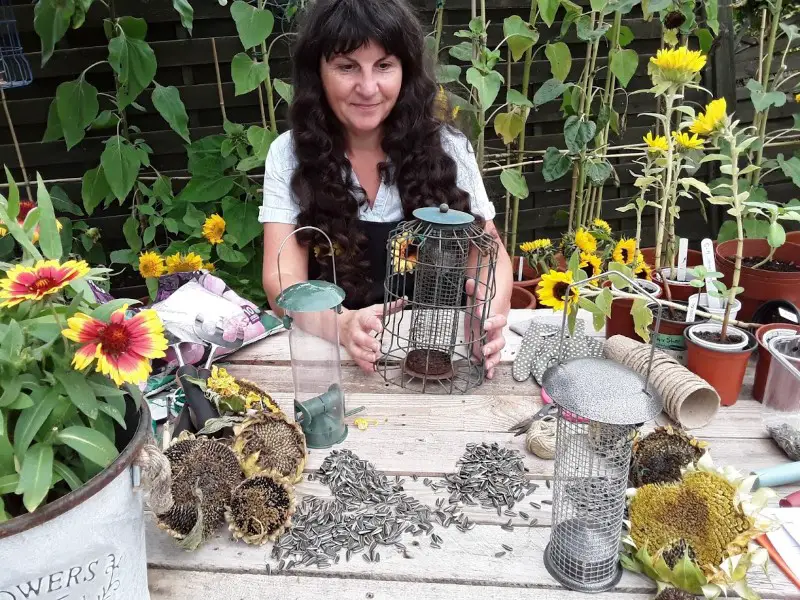
Best Bird Feeders for Sunflower Seeds
I love providing the birds with my homegrown sunflower seeds. It gives me great pleasure watching them feast on the fruits of my labor. And when food is scarce during the winter months I like to help them keep the seeds for themselves.
Providing a bird feeder, that deters other wildlife from grabbing a quick and easy free lunch is a must these days. In the past, no sooner had I filled up feeders that within hours (sometimes minutes) it’s been dislodged, broken into and all offerings were eaten!!
Don’t get me wrong, I love giving everything wild some dinner, but some critters get more than their fair share when its easy pickings. So, let’s make it a bit harder for them, whilst giving our intended feathered friends a safe place and bountiful snacks to enjoy in peace.
My article The Best Bird Feeders for Sunflower Seeds is dedicated to finding the right bird feeder for your needs. I’ve found all the best feeders in varying price ranges, so there’s something for everyone.
I give tips and hints of what to use, and what not to use when cleaning and maintaining them, so no harm comes to any of our furry or feathered friends.
And if you can’t find the feeders you want locally, I’ve found them on Amazon for you 🙂
Harvesting and Drying Sunflower Seed Heads for wildlife
Here’s a nifty idea to help feed your wildlife during winter, without all the hassle of plucking and processing all the sunflower seeds. It’s a great idea if you haven’t the bird feeders at hand.
When the sunflower head is starting to droop, due to the heaviness of the seeds forming, and the petals are starting to dry and fall, this will be a good time to harvest the bloom to dry out as it is. Here’s how…
- Cut the stalk 4 to 6 inches down from the back of the head. Having this length of the stalk will give you something to tie the twine and wrap the bag, or paper around in order to hang the bloom upside down.
- Place the cut bloom upside down in a brown paper bag, or covered in newspaper. Using paper will help draw out the moisture so it evaporates offs and won’t leave any condensation. condensation might cause mildew and damp.
- hang the bagged and tied sunflower bloom in a dry, damp free place until it has completely dried out, then…
- Remove all the paper and re-tie the sunflower head with twine and secure it in a tree, hang from a hook or wherever your wildlife may visit.
Wherever it’s placed, the wildlife will soon find it and be very thankful to you.
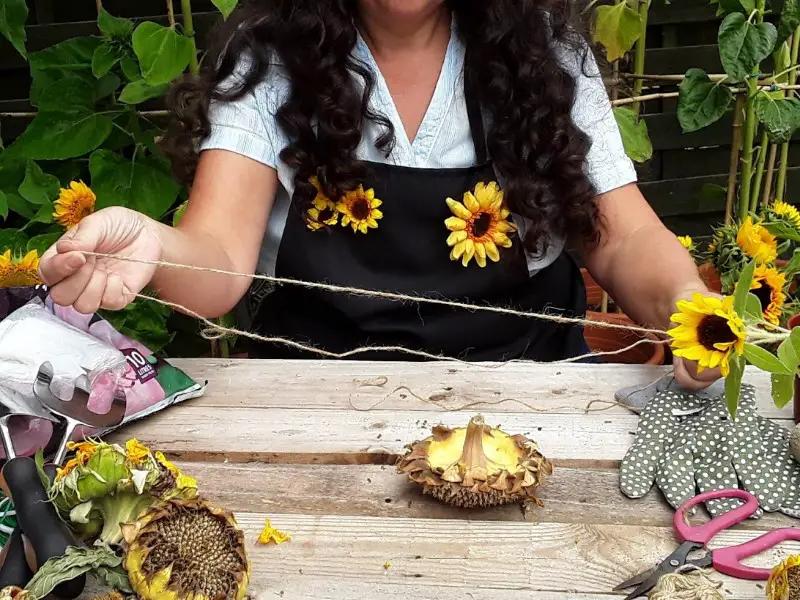
use a good length of twine 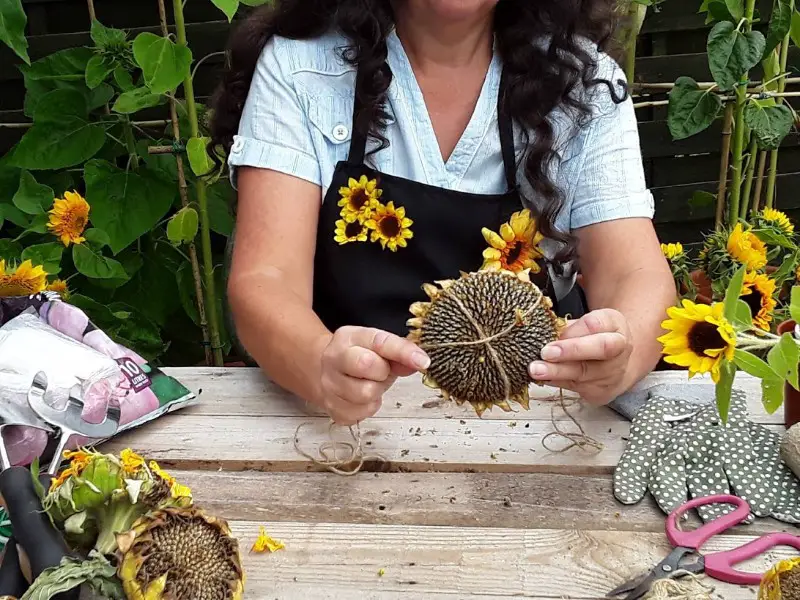
wrap around 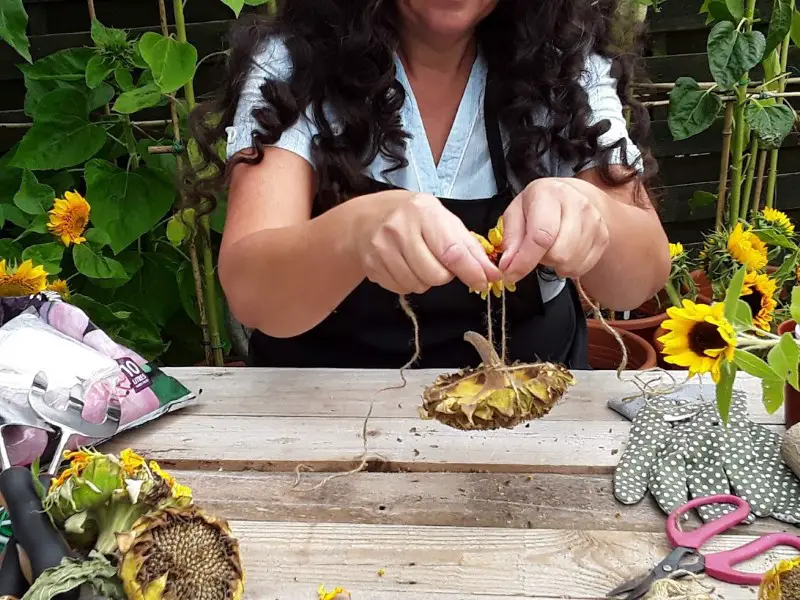
secure and tie a knot 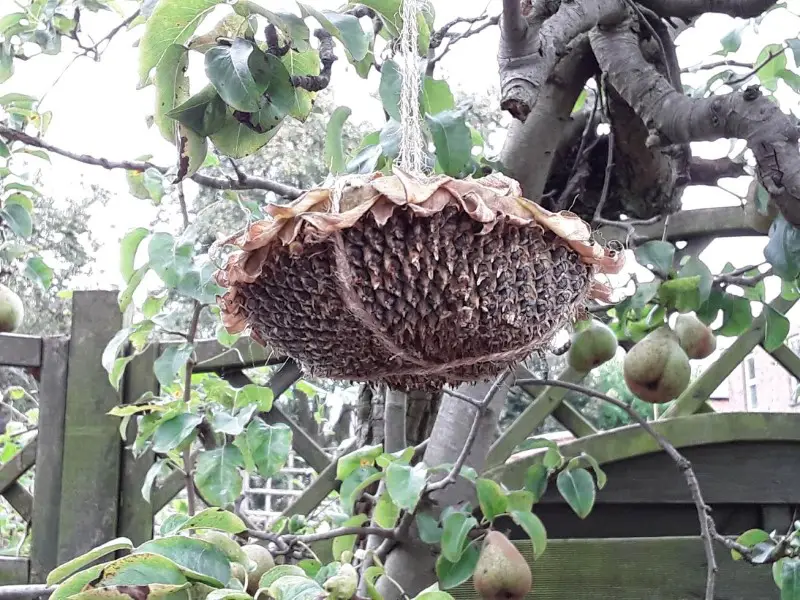
and hang for the birds to find
Top Tip: The best sunflower to grow and harvest for the birds and other wildlife are Black Oil Sunflower Seeds and Mammoth Grey Striped. These varieties are easy to grow, their seed yield is huge, they are high in energy and the shells are easily opened by small birds.
If you can’t find them locally, I’ve found them for you on amazon
How to Roast Sunflower Seeds
How To Roast Sunflower Seeds is an article I’ve dedicated to this subject. It has lots of yummy flavorings for all the family, such as honey roasted, sweet cinnamon, BBQ and lime with chili flavor.
You can eat sunflower seeds raw with, or without their shells on and by using a simple technique, I show you how to remove the shells from sunflower seeds. Also, I have a great tip on how to get more flavor sticking to them.
My Other Helpful Sunflower Guides and Articles
I hope my other articles will help you with all your sunflower needs. I’ve included quick and easy guides, diagrams and charts for you to download, pin, post or print out.
How to Roast Sunflower Seeds
What Are the Benefits and Nutritional Values of Sunflower Seeds
31 Most Amazing Sunflowers. With Height Guide. Tried and Tested
How to Grow Amazing Sunflowers
Do Sunflowers Need a Lot of Water
Why are My Sunflowers Drooping, Falling Over or Wilting
Best Sunflower Companion Plants, Vegetables and Flowers

My Final Thoughts
Harvesting time might be the end of growing sunflowers this year, but it doesn’t stop there.
It’s fantastic that we can store these wonderful seeds throughout the winter to eat raw, cooked, or to replant the following year. And how wonderful it is to store them and feed the wildlife when they need help finding a meal to get them through their winter too.
Sunflowers and their seeds have been grown as a crop for thousands of years, and it’s easy to see why. They’re full of nutrients and goodness, they taste great and are versatile too.
Whether it’s your first time harvesting sunflower seeds, or you just needed a refresher course, I hope I’ve helped and given some tips and fun ideas, that you and your family can enjoy together when you harvest sunflower seeds this fall.

